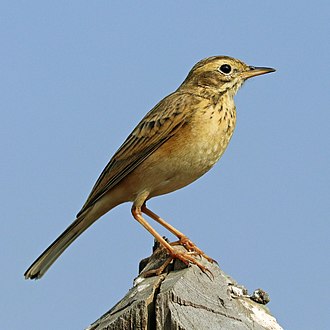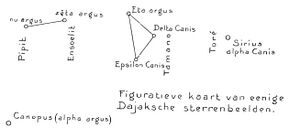Pipit
Among the Kendayan (Dayak Kenayatn) people of West Kalimantan province, Borneo, Indonesia, the star ν Pup is identified as "Pipit", The Little Rice Thief (a species of sparrow).
Etymology and History
ν Pup (then ν in Argo Navis) was identified as "Pipit", or sparrow, by ethnographer M.C. Schadee (1914) in a paper on time reckoning amongst the Kendayan ("Landak Dayak") people. It is one of a pair of stars (the other being ζ Pup) forming an asterism whose name was recorded by Schadee as Ĕnsoelit. This is also the name of a bird -- "one that often causes great damage to rice in paddy fields".
"Ĕnsoelit, naam van een vogel, welke vaak groote schade aan de te velde staande padi toebrengt. Ĕnsoelit bestaat uit zeta en nu Argus. Nu Argus heet ook pipit = musch."
English
Ĕnsoelit, name of a bird which often causes great damage to the young rice plants ('padi') in the fields. Ĕnsoelit consists of ζ and ν Argus. ν Argus is also known as pipit = musch.
In modern Dutch the latter bird is known as 'mus' which Wikipedia calls a Old World Sparrow. Ensoelit is the Dutch ethnographer's transcription of a Kenyatan name which has not been found elsewhere. "Pipit", or "Burung Pipit" in Indonesian, has also been identified as Lonchura striata, i.e., the white-rumped munia or striated finch.[1]
A footnote in Schadee's paper identifies them as 'rijstdiefjes' = little rice thieves. They are also known as 'rijstvogels' of rice birds and are commonly known as Java sparrows. "The [two] rice thieves are close to Sirius".[2]
Note that the modern star names are given as ν and ζ Arg (constellation name "Argo" with abbreviation "Arg" was standardized by the IAU in 1922, although six years later, the decision upon Delporte's borderlines made it unnecessary to be used throughout the 20th century; it is still useful in historical texts).
Confusion of Pipit and Ensoelit
Schadee's text stating that "Pipit" is a sparrow and "Ensoelit" is also a bird that named a constellation contradicts his diagram that seems to suggest that "Ensoelit" and "Pipit" are two star names of one (unnamed?) constellation. This leads to the question if the "ensoelit" bird has a similarly important (or any) significance in any Indonesian culture.
After the spelling reform in Indonesia in 1980, Ensoelit is now spelled "ensulit"; it originates from the "Dayak Iban"-language, spoken in West Borneo and close to Malaysian language. On Java, for instance, it is not common and the term "ensulit" is not known at all. The Dayak are a huge ethnic with many subcultures (languages and ritual traditions). Schadee got the term from the Dayak Landak, we also found it in Dayak Kanayatan and Dayak Simpakng,
The term "ensulit" is used only in the compound word "burik ensulit", meaning: "the bad looking feather". It refers to a specific feather of some roosters at the point where its tail joins the body. Superstition has it that a rooster with this feather is "the lucky one" in cockfights. It is considered to bring its owner fortune.
So, this is a misunderstanding by Schadee: "Ensoelit" is not a bird.
Etymology and Species of birds
There are also other species of bird called "Pipit", e.g. the American Pipit which lives in the Americas, Northeast and East Asia. However, the star name seems to be applied in Indonesia only. Today, the term designates a genus of small passerine birds.
However, the term "Pipit" occurred in European languages only in the middle of the 18th century and is considered probably imitative (cf. Oxford Languages). We consider the star name as indigenous Indonesian and the term in modern biology a take-over from this original.
Mythology
The rice bird is mentioned in the local lore of the Kanayatn Dayak community in West Kalimantan (Borneo) relating to the divine origin of rice:
... which comes from a sprig of rice from Jubata (God) on an onion mountain that was stolen by a sparrow and the rice fell into the hands of ne Jaek who was wailing. It was from here that humans, in the Dayak language called Talino, began to know rice as their staple food.[3]
Naik Dango (also known as Gawai Dayak), a ceremony of the Dayak Kanayatn people, is a form of local wisdom that is a legacy of the ancestors of the Dayak people. It is an expression of gratitude and ritual to God (Jubata) so that the harvest in the coming year will also be abundant and free from pests and disasters.
The Dayak Simpakng Community avoids four kinds of birds as a sign of bad luck: owl (oleng kuap/burung hantu), sparrow (burung pipit), rock magpigie bird (gagurak/murai batu) and paddy kareo bird (keruak/kareo padi). This particular community believes that if those birds enter their house at night, a bad event will follow: they are a message from Satan or the devil who wants to disturb the people. In order to prevent the oath from coming true, they have to kill any birds that come in; otherwise they have to leave the house for three days. If they want to come back to the house, it must be ritually cleansed by a shaman using a chicken and rice as well as reciting mantras.[1]
IAU Working Group on Star Names
While "pipit" is a Western bird name it also appears to be a local (Kenyatan) name for a bird, whether a sparrow or munia/finch. It is clearly identified by Schadee with ν Pup (SIMBAD). The blue (B8) giant star has 3.17 mag in V. We are unaware of any other cultural names for Nu Pup.
WGSN thanks Youla Azkarrula (from Bali, Indonesia) for valuable contributions to this topic.
In August 2024, WGSN adopted "Pipit" for ν Pup.
Weblinks
- Website of the IAU WGSN: https://exopla.net/
Reference
- ↑ 1.0 1.1 Yulius Yogi, M. Sofwan Anwari, S.M. Kartikawati (2019). "Etnozoologi sebagai pertanda oleh masyarakat dayak simpakng di desa mekar raya kecamatan simpang dua kabupaten ketapang" JURNAL HUTAN LESTARI, Vol. 7 (2) : 716 – 722, [link]
- ↑ Schadee, Marie C. (1914)]. “De Tijdrekening bij de Landak-Dajaks in de Westerafdeeling van Borneo”. Bijdragen tot de Taal-, Land- en Volkenkunde, 69, 130–139, p. 132 [JSTOR link].
- ↑ Saiful Bahri & Emi Tipuk Lestari, "Naik Dango Tradition in Supporting the Social Integration of Ethnic Dayak Community Kanayatn Binua Sunge Samak Kubu Raya Regency, West Kalimantan", Komunitas: International Journal of Indonesian Society and Culture, 14(1) (2022), pp. 53-65 [cf. p. 62, slightly modified] [doi link].






